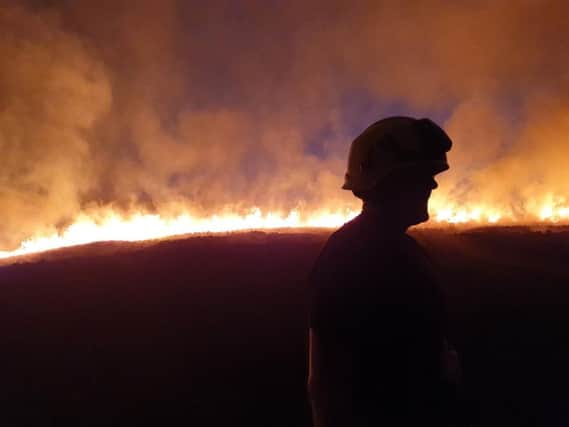Moor fires increase as crews spell out the risks


Up to 170 firefighters from five brigades tackled major blazes on moorland above Marsden and Ilkley during the Easter weekend.
The crews had to contend with intensely demanding situations to ensure the blazes were extinguished as quickly as possible and did not damage the fragile habitats. The Marsden moor blaze alone has decimated as much as £200,000 of work to restore wildlife habitats.
Advertisement
Hide AdAdvertisement
Hide AdThe moorland fires at Marsden and Ilkley were the fifth and sixth blazes which West Yorkshire Fire and Rescue Service has been called to this year alone. Last year, the brigade attended four blazes.
Jim Butters, the area manager of West Yorkshire Fire and Rescue Service, said: “Moorland fires are definitely on the increase and consequently they can put people, property and livestock at considerable risk. They are very resource intensive as well, but a lot of pre-planning goes into tackling them by a dedicated team.
“We work with a lot of partners and have formed good relationships with the National Trust and local farmers to make sure we have dedicated access points to the moors so we can get there as quickly as possible.
“It’s a bit like a big jigsaw and all the pieces come together to complete it. Our wildfire officers are able to predict how the fire will spread and get our crews to act accordingly.”
Advertisement
Hide AdAdvertisement
Hide AdOnce crews have reached the location of a blaze, a host of specialised equipment comes into force to tackle the flames.
Mr Butters said: “We have a whole host of equipment, including the helicopter. At Ilkley, over 800 litres of water was sprayed to help extinguish the blaze.
“We also have the handbag pumps (which are carried in backpacks) and utilise the water supplies out there. We will have our high volume pumps linked directly to the reservoirs to get as much water as we can.
“The ground, however, is so dry and the fire is deep-sealed that just spraying water will not put out the fire. We have our backpack-mounted blowers, as well as the square robust matts which we whack on the vegetation to extinguish the flames.”
Advertisement
Hide AdAdvertisement
Hide AdMr Butters also stressed the importance of firefighters’ welfare, and said: “We have to make sure the crews are fed and watered and when we are there for days at a time. It’s not a case of just popping to the supermarket, we are in the middle of nowhere.
“When the crews are wearing all their kit and carrying hose lines, they are burning calories like there’s no tomorrow.”
At many of the moorland fires, support has been drafted in from North Yorkshire Fire and Rescue Service, which too has seen a rise in the number of blazes. Crews attended 29 heathland and moorland fires in 2018. So far in 2019, they have attended 23.
Station manager James Manning said: “The fact that we have experienced this good spell of weather means we have seen an increase in incidents and it has far exceeded our targets of 2018. We assisted with Ilkley Moor and last year at Saddleworth we sent resources over for a number of weeks.”
Prevention is key
Advertisement
Hide AdAdvertisement
Hide AdBoth North Yorkshire and West Yorkshire fire services state prevention and knowledge is the key to stopping the increase in the number of moorland fires.
Any members of the public visiting the moors are advised to take the following advice.
Mr Butters said: “We ask anyone who smokes to dispose of their cigarettes properly and never leave glass bottles around as they refract light.”
Mr Manning added: “If you are having a BBQ or camping, make sure you are in a designated area and check with the park as to what their guidelines are as they can change.”